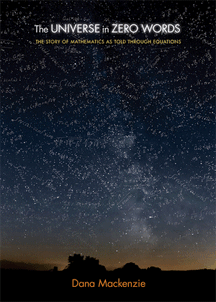By David L. Kirchman
The editor of A Brief History of Time told Stephen Hawking that every equation decreases a book’s readership by half, so the British physicist included only one, one so famous and familiar that it was unlikely to scare anyone away. The Universe in Zero Words has not only Einstein’s E=mc2, but another twenty-three equations, not counting other mathematical expressions with supporting roles in Dana Mackenzie’s story. If Hawking’s editor is right, few readers would be left after all that math. That would be a shame, as this beautiful book is much more than a bunch of equations.
The book certainly has them, lightly and lucidly discussed in short chapters (one is only four pages long). Starting with the seemingly simple, 1+1=2, Mackenzie uses this equation to discuss the foundation of modern mathematics and the possibility that one plus one may equal three somewhere. We then read that Pythagoras wasn’t actually the first to discover his eponymous theorem, probably having learned it from the Babylonians. Mackenzie reminds us that the scarecrow in the Wizard of Oz declaims the theorem, albeit erroneously, to demonstrate his newly acquired brain. The scarecrow would have been more impressive if he had read Mackenzie and discussed quaternions and the Chern-Gauss-Bonnet equation. Only those readers steeped in financial arcana will have heard of the Black-Scholes equation, the “formula that killed Wall Street,” according to Wired. More sublime is an equation from Lenohard Euler, voted the “most beautiful” by readers of Mathematical Intelligencer.
The focus on equations certainly befits a book subtitled The Story of Mathematics as Told through Equations. Yet a reader could skip the equations and still learn much, perhaps even enjoy the book more. In some cases, the equations are like Japanese calligraphy, more to be admired than understood. More standard works of art fill the book, used imaginatively by Mackenzie to illustrate mathematical points. How did he see the connection between the symmetry of a Galois group and an earthenware tile from the fifteenth century? The art, diagrams, and colorful marginalia seen here are reasons why we still have printed books.
Rather than the equations, arguably the main protagonists of Mackenzie’s story are the men who discovered the mathematics. (There are no female mathematicians in this book, a sign of the eras covered here.) Mackenzie’s story is a history of mathematics recounted through vignettes of the famous and not so famous. In addition to Pythagoras and Einstein, we meet William Rowan Hamilton who knew all European languages (as well as Hebrew, Latin and Greek) by ten years old and counted William Wordsworth as a friend. When not thinking of ethereal equations Évariste Gaios fought in the French Revolution only to die in a duel, “the victim of an infamous coquette and her two dupes.” Kurt Gödel upended the foundations of mathematics (perhaps one plus one can equal three) and befriended Einstein while believing in ghosts and fearing he was being poisoned.
Yet, in the end, there is still the calligraphy. Many readers will have a better chance of understanding Japanese than a Fourier series, and the aesthetics of Euler’s equation will go unappreciated by most. This book with its 216 pages is too short to travel far into a universe with zero words. That’s okay. Even if this universe is beyond us, Mackenzie’s book is an enjoyable read, giving a glimpse of the wonder and power and even the beauty of mathematics.
David L. Kirchman (ΦBK, Lawrence University, 1976) is the Maxwell P. and Mildred H. Harrington Professor Marine Biosciences at the University of Delaware and a resident member of the Alpha of Delaware chapter of Phi Beta Kappa.




